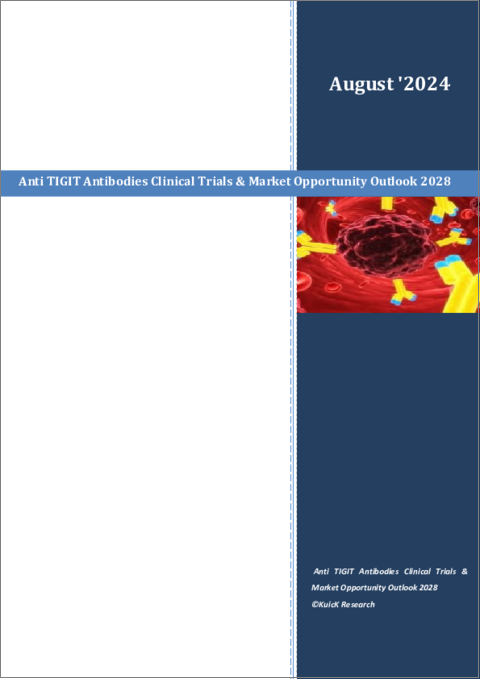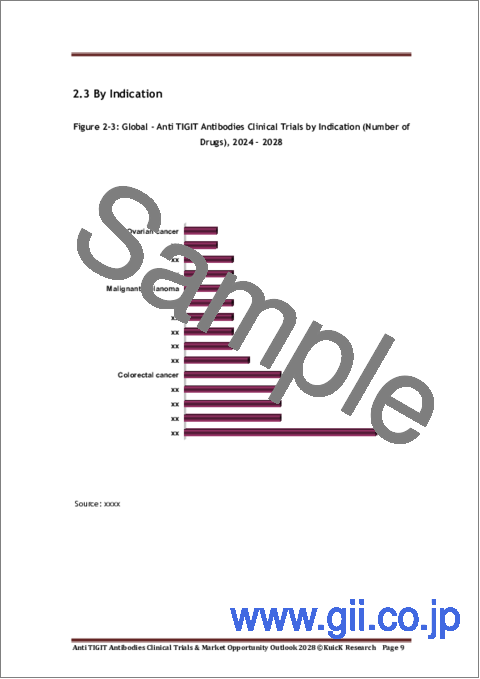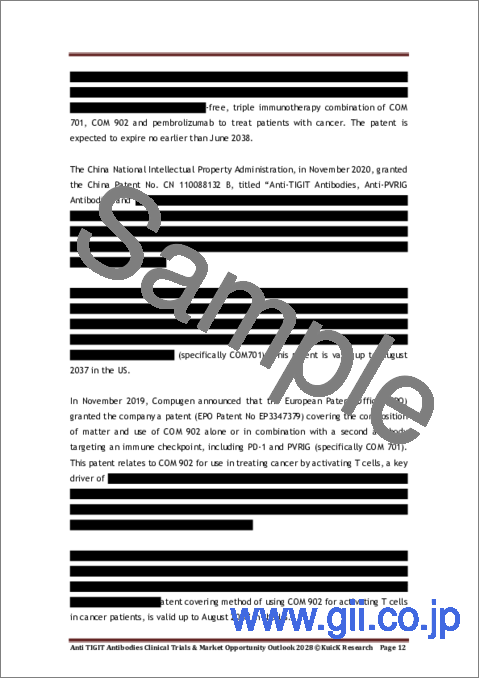|
|
市場調査レポート
商品コード
1526806
抗TIGIT抗体市場:臨床試験と市場機会の見通し:2028年Anti TIGIT Antibodies Clinical Trials & Market Opportunity Outlook 2028 |
||||||
|
|||||||
| 抗TIGIT抗体市場:臨床試験と市場機会の見通し:2028年 |
|
出版日: 2024年08月01日
発行: KuicK Research
ページ情報: 英文 195 Pages
納期: 即日から翌営業日
|
全表示
- 概要
- 図表
- 目次
抗TIGIT抗体は、がん免疫療法における有望なアプローチとして登場し、様々なタイプのがん、特に固形がん患者に新たな希望をもたらしています。TIGIT(T cell immunoreceptor with Ig and ITIM domains)は、T細胞やナチュラルキラー(NK)細胞に発現する抑制性受容体で、免疫応答の調節に重要な役割を果たしています。TIGITを標的とすることで、がん細胞を認識し排除する免疫系の能力を高め、がん治療戦略に革命をもたらす可能性があります。
がん免疫療法の標的としてのTIGITの治療的可能性は、免疫チェックポイント分子としての機能にあります。TIGITがCD155やCD112などのリガンドと相互作用すると、T細胞やNK細胞の活性化を抑制し、がん細胞が免疫監視から逃れることを可能にする可能性があります。抗TIGIT治療アプローチでこの相互作用をブロックすることにより、研究者らは腫瘍に対する免疫反応を再活性化し、がん患者の臨床転帰を改善することを期待しています。
TIGITを標的とする様々なアプローチの中で、モノクローナル抗体は最も広く使われ、有望な薬剤として浮上してきました。これらの抗体はTIGITに特異的に結合するように設計されており、TIGITとそのリガンドとの相互作用を阻害し、免疫系の"断絶"を解除します。抗体の高い特異性と比較的低い毒性は、臨床開発の魅力的な候補となります。
抗TIGIT抗体開発は急速に進展しており、現在50以上の候補が臨床開発段階にあります。この強力なパイプラインは、がん治療におけるこのアプローチの大きな関心と可能性を裏付けています。その中で、5つ以上の抗TIGIT抗体が第3相臨床試験に進んでおり、これは薬事承認前の臨床開発の最も進んだ段階です。これらには、製薬マーカーのリーダーであるメルク・ジェネンテック社とベイジーン社がそれぞれ開発したビボストリマブ、ティラゴルマブ、オシペリリマブが含まれます。
当レポートでは、世界の抗TIGIT抗体市場について調査し、市場の概要とともに、抗TIGIT抗体の臨床パイプライン、適応症別、国別動向、および市場に参入する企業の競合動向などを提供しています。
目次
第1章 抗TIGIT抗体のイントロダクション
第2章 世界の抗TIGIT抗体臨床試験の概要
- 企業別
- 国別
- 適応症別
- 患者セグメント別
- 相別
第3章 企業、適応症、相別の世界の抗TIGIT抗体の臨床パイプライン
- 研究
- 前臨床
- 第I相
- 第I/II相
- 第II相
- 第III相
第4章 世界の抗TIGIT抗体市場の見通し
- 現在の臨床および市場動向
- 今後の市場見通し
第5章 抗TIGIT抗体の市場動向、適応症別
- がん
- 自己免疫疾患および炎症性疾患
- 微生物感染症
第6章 抗TIGIT抗体市場、国別
- 米国
- 中国
- 韓国
- オーストラリア
- 英国
第7章 TIGIT療法の複合アプローチ
第8章 TIGITとPD1またはPDL1の共阻害
第9章 世界の抗TIGIT抗体市場力学
- 市場促進要因
- 商業化の課題
第10章 競合情勢
- Akeso Biopharma
- BeiGene
- Bio-Thera Solutions
- Biotheus
- Compugen
- FutureGen Biopharmaceutical
- Merck Sharp & Dohme
- Nanjing Sanhome Pharmaceutical
- OriCell Therapeutics
- Phio Pharmaceuticals
- Roche
- Shanghai Henlius Biotech
- Shanghai Junshi Biosciences
- Simcere Pharmaceutical Group
- Tasrif Pharmaceutical
List of Figures
- Figure 1-1: TIGIT/DNAX Accessory Molecule-1 Pathway
- Figure 1-2: TIGIT Inhibitor - Proposed Mechanism of Action
Figure 1*3: TIGIT Inhibitor - Mechanism of Action
- Figure 1-4: Binding Efficacy of Monoclonal Antibody
- Figure 1-5: Binding Efficacy of Bispecific Antibodies
- Figure 1-6: Advantages of Small Molecule Drugs over Therapeutic Antibodies
- Figure 2-1: Global - Anti TIGIT Antibodies Clinical Trials by Company (Number of Drugs), 2024 -2028
- Figure 2-2: Global - Anti TIGIT Antibodies Clinical Trials by Country (Number of Drugs), 2024 - 2028
- Figure 2-3: Global - Anti TIGIT Antibodies Clinical Trials by Indication (Number of Drugs), 2024 - 2028
- Figure 2-4: Global - Anti TIGIT Antibodies Clinical Trials by Patient Segment (Number of Drugs), 2024 - 2028
- Figure 2-5: Global - Anti TIGIT Antibodies Clinical Trials by Phase (Number of Drugs), 2024 -2028
Figure 4 1: Global TIGIT Therapy Fundamental Companies
Figure 4 2: Future TIGIT Market
- Figure 5-1: Anti-LAG-3 (BMS-986016) & Anti-TIGIT (BMS-986207) Phase I/II (NCT04150965) Study - Initiation & Completion Year
- Figure 5-2: Compugen TIGIT Antibody Cancer Pipeline
- Figure 5-3: Keio University School of Medicine Research Study
- Figure 5-4: University of Zurich Investigation for TIGIT Antibody to Cure Viral Infection
- Figure 5-5: Combination TIGIT Therapy for Viral Infections
- Figure 6-1: PD-1 Inhibitor Zimberelimab (AB122) With TIGIT Inhibitor Domvanalimab (AB154) Phase II (NCT05130177) Study - Initiation & Completion Year
- Figure 6-2: iTeos Therapeutics & GSK Triumph Enrolment Milestone
- Figure 6-3: Bristol Myers Squibb & Agenus Preclinical Candidates, BMS-986442
- Figure 6-4: Clinical TIGIT Therapy Pipeline in China
- Figure 6-5: JS006 Monotherapy and in Combination With Toripalimab Phase I (NCT05061628) Study - Initiation & Completion Year
- Figure 6-6: Chinese Companies TIGIT Candidates Insights
- Figure 6-7: Zimberelimab with Domvanalimab Phase II (NCT04262856) Study - Initiation & Completion Year
- Figure 6-8: Aspects Influencing South Korea TIGIT Market
- Figure 6-9: HLX301 Phase I/II (NCT05102214) Study - Initiation & Completion Year
- Figure 6-10: AZD8205 Monotherapy or in Combination with Anticancer Drugs Phase I/II (NCT05123482) Study - Initiation & Completion Year
- Figure 6-11: Key Players in UK TIGIT Market
- Figure 7-1: TIGIT Therapy Combinations
- Figure 9-1: Global - Cancer Incidences & Deaths (Million), 2020 & 2025
- Figure 9-2: TIGIT Inhibitor Market Drivers
- Figure 9-3: Stages of Drug Development
List of Tables
- Table 1-1: Anti-TIGIT Monoclonal Antibodies in Development
- Table 5-1: Ongoing Cancers Clinical Trials for TIGIT Therapy
- Table 6-1: Ongoing US Clinical Trials for TIGIT Therapy
- Table 6-2: Ongoing China Clinical Trials for TIGIT Therapy
- Table 7-1: Ongoing Preclinical & Clinical Trials for Combination of TIGIT inhibitors
Anti TIGIT Antibodies Clinical Trials & Market Opportunity Outlook 2028 Report Highlights:
- Anti TIGIT Antibodies In Clinical Trials: > 50 Antibodies
- First Anti TIGIT Antibody To Get Approval Within Next 5 Years
- Global Anti TIGIT Antibodies Clinical Pipeline Insight By Company, Indication and Phase
- Insight On More Than 50 Anti TIGIT Antibodies In Clinical Trials
- Anti TIGIT Antibodies Market Trends by Indication & Country
- Global Anti TIGIT Antibodies Market Dynamics
Anti TIGIT antibodies have emerged a promising approach in cancer immunotherapy, offering new hope for patients with various types of cancers, particularly solid cancers. TIGIT (T cell immunoreceptor with Ig and ITIM domains) is an inhibitory receptor expressed on T cells and natural killer (NK) cells, playing a crucial role in modulating immune responses. By targeting TIGIT, researchers aim to enhance the immune system's ability to recognize and eliminate cancer cells, potentially revolutionizing cancer treatment strategies.
The therapeutic potential of TIGIT as a target for cancer immunotherapy lies in its function as an immune checkpoint molecule. When TIGIT interacts with its ligands, such as CD155 and CD112, it suppresses T cell sand NK cell activation, potentially allowing cancer cells to evade immune surveillance. By blocking this interaction with anti-TIGIT therapeutic approaches, researchers hope to reinvigorate the immune response against tumors, leading to improved clinical outcome for cancer patients.
Among the various approaches for targeting TIGIT, monoclonal antibodies have emerged as the most widely used and promising agents. These antibodies are designed to specifically bind to TIGIT, preventing its interaction with its ligands and thus releasing the "breaks" on the immune system. Their high specificity and relatively low toxicity of antibodies make them attractive candidates for clinical development.
The field of anti-TIGIT antibody development has seen rapid progress, with over 50 candidates currently in clinical development. This robust pipeline underscores the significant interest and potential of this approach in cancer treatment. Among these, more than five anti TIGIT antibodies have advanced to phase 3 clinical trials, representing the most advanced stage of clinical development before potential regulatory approval. These include Vibostolimab, Tiragolumab and Ociperlimab, developed by the pharmaceutical marker leaders, Merck Genentech and BeiGene, respectively.
These phase 3 clinical trials are assessing the safety and efficacy of these anti-TIGIT antibodies in various cancer types, with a particular focus on non-small cell lung cancer (NSCLC). The emphasis on NSCLC is not surprising, given its high prevalence and the need for more effective treatment options. NSCLC represents a significant portion of lung cancer cases and has shown promising responses to immunotherapy approaches in the past.
Several key factors are driving the market potential of anti-TIGIT antibodies. Firstly, there remains a substantial unmet medical need in cancer treatment, especially for patients who do not respond to or develop resistance to existing immunotherapies. Anti-TIGIT antibodies offer a novel mechanism of action that could address these challenges. Moreover, these antibodies show promising results in combination with established therapies like PD-1/L1 inhibitors, potentially expanding the market for both drug classes and improving treatment outcomes. This becomes visible in Merck's vision of developing a coformulation of its anti-TIGIT antibody Vibostolimab with its blockbuster anti-PD-1 antibody pembrolizumab for the treatment of various solid tumors.
The broad applicability of anti-TIGIT antibodies across various cancer forms presents another significant market opportunity. While a majority of clinical trials currently focus on NSCLC, many other ongoing clinical trials are exploring their efficacy in other solid cancers tumors and hematological malignancies, which could lead to multiple approved indications, consequently increasing the anti-TIGIT antibody market size.
As evident from the examples above, the competitive landscape for the anti-TIGIT antibody market is dynamic, with major pharmaceutical companies and biotechnology firms vying for market share. While Vibostolimab leverages the company's strong position in the immuno-oncology market, another, Domvanalimab, being developed by Gilead Sciences and Arcus Biosciences, benefits from a partnership between a major pharmaceutical company and a competent biopharmaceutical company.
In conclusion, anti-TIGIT antibodies not only represent a significant advancement in cancer immunotherapy, but also present many opportunities for drug development and market expansion. With its potential to address unmet medical needs, broad applicability and alignment with personalized medicine, this emerging class of drugs is poised to capture a substantial portion of cancer immunotherapy market.
Table of Contents
1. Introduction to Anti TIGIT Antibody
- 1.1 Overview
- 1.2 Mechanism of Anti TIGIT Antibodies
- 1.3 Clinical Approaches to Target TIGIT
2. Global Anti TIGIT Antibodies Clinical Trials Overview
- 2.1 By Company
- 2.2 By Country
- 2.3 By Indication
- 2.4 By Patient Segment
- 2.5 By Phase
3. Global Anti TIGIT Antibodies Clinical Pipeline By Company, Indication and Phase
- 3.1 Research
- 3.2 Preclinical
- 3.3 Phase I
- 3.4 Phase I/II
- 3.5 Phase II
- 3.6 Phase III
4. Global Anti TIGIT Antibodies Market Outlook
- 4.1 Current Clinical & Market Trends
- 4.2 Future Market Outlook
5. Anti TIGIT Antibodies Market Trends by Indication
- 5.1 Cancer
- 5.2 Autoimmune & Inflammatory Disorders
- 5.3 Microbial Infections
6. Anti TIGIT Antibodies Market By Country
- 6.1 US
- 6.2 China
- 6.3 South Korea
- 6.4 Australia
- 6.5 UK
7. Combinations Approaches for TIGIT Therapy
8. TIGIT Co Inhibition with PD1 or PDL1
9. Global Anti TIGIT Antibodies Market Dynamics
- 9.1 Market Drivers
- 9.2 Commercialization Challenges
10. Competitive Landscape
- 10.1 Akeso Biopharma
- 10.2 BeiGene
- 10.3 Bio-Thera Solutions
- 10.4 Biotheus
- 10.5 Compugen
- 10.6 FutureGen Biopharmaceutical
- 10.7 Merck Sharp & Dohme
- 10.8 Nanjing Sanhome Pharmaceutical
- 10.9 OriCell Therapeutics
- 10.10 Phio Pharmaceuticals
- 10.11 Roche
- 10.12 Shanghai Henlius Biotech
- 10.13 Shanghai Junshi Biosciences
- 10.14 Simcere Pharmaceutical Group
- 10.15 Tasrif Pharmaceutical






